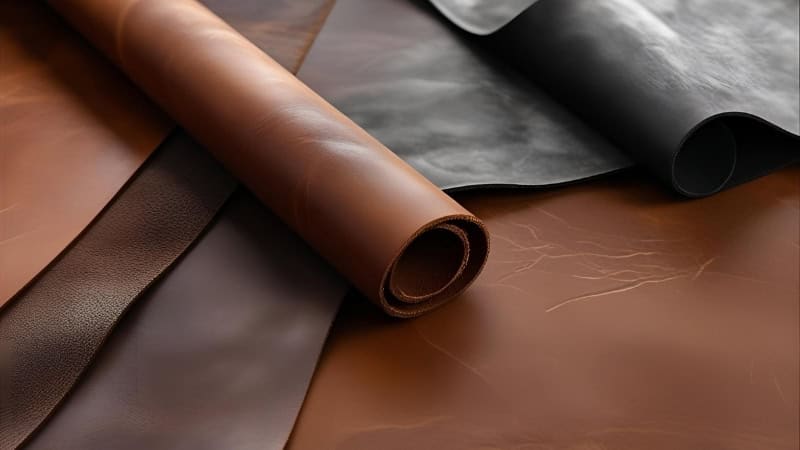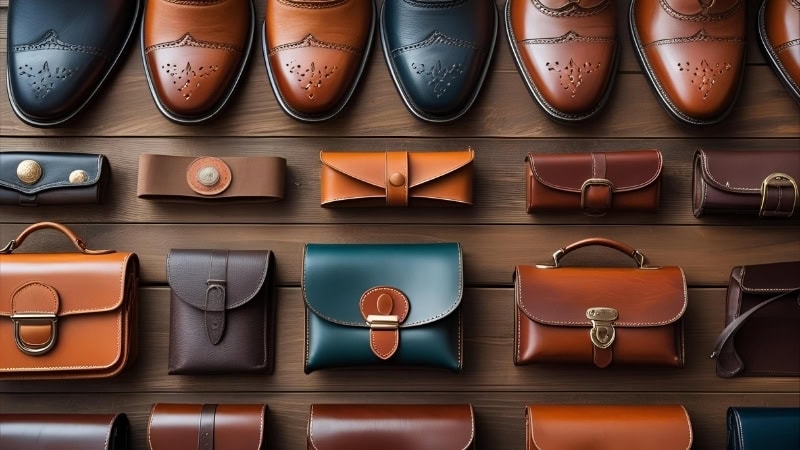When you think of luxury, elegance, and durability in leather, Napa leather often comes to mind. Is Napa leather really worth the extra cost? Or should you just go for regular leather?
If you’ve been scratching your head, wondering which leather type is best for your lifestyle, you’re not alone.
It’s a common dilemma, and I’m here to break it down for you.
Whether it’s the luxe feel of Napa leather or the affordability and versatility of regular leather, let’s dive deep into the real pros and cons, along with how to keep your investment looking brand new.
Dig Deeper: What Is Nappa Leather? What to Know About this Supple Luxury
What is Napa Leather?
Before we dive into the details, let’s start with the basics.
Napa leather is often associated with high-end products, and for good reason. It’s made from the softest, most delicate hides, typically lambskin or calfskin, which are treated with care and skill during the tanning process. The end result is a luxurious, supple, and incredibly smooth leather that’s sought after in the fashion world.
Napa leather’s softness is its signature feature, making it the leather of choice for luxury brands that want to provide a rich, buttery feel. It’s perfect for items that you’ll wear or use often because it feels comfortable against your skin and molds to your body’s shape.
Pros of Napa Leather:
- Luxurious Softness: Napa leather has a buttery-soft feel that’s unmatched by other leathers. It molds beautifully to your body or its environment.
- Aesthetic Appeal: It’s sleek, shiny, and smooth, making it perfect for fashion-forward items.
- Long-Term Value: When cared for properly, Napa leather can last for decades and age beautifully.
Cons of Napa Leather:
- Expensive: The premium quality comes at a cost.
- Prone to Scratches: The softness of Napa leather means it’s more vulnerable to damage from scratches and scuffs.
- High Maintenance: Napa leather requires more attention to keep it looking pristine.
What is Regular Leather?
Regular leather, on the other hand, is more of a general term that encompasses various types of leather. The most common types you’ll encounter are full-grain leather, top-grain leather, and genuine leather.
- Full-grain leather is the highest quality, made from the entire hide, with all its imperfections left intact. It’s highly durable and develops a beautiful patina over time.
- Top-grain leather is slightly more processed than full-grain, meaning it’s sanded to remove blemishes, but it still maintains a lot of durability.
- Genuine leather is the lowest grade, made from the leftover scraps of the hide and often heavily processed.
Pros of Regular Leather:
- Durability: Regular leather (especially full-grain) is tough, long-lasting, and can withstand wear and tear. It’s perfect for everyday use.
- Affordability: Compared to Napa leather, regular leather is generally more affordable, especially if you opt for top-grain or genuine leather.
- Versatility: It’s a practical option for a wide range of items, from casual handbags to sturdy jackets.
Cons of Regular Leather:
- Less Soft: Regular leather may not have the same buttery softness that Napa leather offers, especially in more affordable grades like genuine leather.
- Can Look Rough: Full-grain leather can look a bit more rustic or raw, which may not appeal to those seeking a sleek, polished aesthetic.
Recommended Read: Leather vs Suede: What’s the Real Difference?
Napa Leather vs Regular Leather: Key Differences
Now that we’ve defined both Napa leather and regular leather, let’s look at how they compare in the real world. You might be wondering: is Napa leather truly superior, or does regular leather have some secret advantages?
Let’s break it down.
1. Texture and Feel
Napa leather is known for its silky, smooth texture. It’s incredibly soft, which makes it perfect for items that will be in direct contact with your skin, like bags, wallets, and clothing. It feels luxurious and light, making it an absolute dream to touch.
Regular leather can vary in texture depending on the type. Full-grain leather is a little rougher and more robust, while top-grain leather can feel smoother but not quite as soft as Napa. Genuine leather, however, is often a bit stiffer and feels more “processed.”
Which is better? If you prioritize a soft, refined feel, Napa leather is the way to go. But if you want something that’s a little more rugged and hearty, regular leather might suit you better.
2. Durability and Longevity
When it comes to durability, regular leather is typically more rugged and resistant to scratches. Full-grain leather, in particular, ages like fine wine, developing a gorgeous patina over time.
However, Napa leather, while luxurious, is more prone to scratching and wear, which is something to consider if you’re planning on using it for everyday items that will get a lot of exposure.
Napa leather: Softer and more prone to scratches, but ages well with proper care.
Regular leather (full-grain): Extremely durable and resistant to wear, often becoming more beautiful with age.
3. Breathability
Napa leather has great breathability due to its natural, smooth texture. This makes it an excellent choice for leather clothing, especially for people who live in warmer climates or prefer a breathable material.
Regular leather, depending on the type, may not be as breathable. For example, genuine leather, while durable, can trap heat and moisture, making it less comfortable in hot weather.
Which is more comfortable? Napa leather tends to be the better option if comfort is your priority.
Recommended Read: How to Waterproof Leather Boots: A Comprehensive Guide
4. Water Resistance
Regular leather, especially full-grain, tends to have better water resistance. While no leather is truly waterproof, regular leather holds up better against moisture and weather elements.
Napa leather, because it’s softer, can absorb water more easily, which could lead to permanent damage if not properly cared for.
5. Cost Comparison
It’s time to talk about money. Napa leather is often significantly more expensive than regular leather. But why is this the case? Well, it comes down to the quality of the raw materials and the craftsmanship required to create Napa leather.
Napa leather is produced from the highest-quality hides, and the tanning process is more meticulous and time-consuming. As a result, the price tag reflects the quality and care involved in its creation. But if you’re on a budget, regular leather can offer you excellent value for money without sacrificing too much in terms of quality.
Recommended Read: Best Way to Clean Leather: The Ultimate Leather Cleaning Guide
Maintenance and Care: Keeping Your Leather Looking Great
Every leather item requires care, but how much maintenance each type needs differs.
Napa Leather Care
- Cleaning: Use a soft cloth and a gentle leather cleaner to wipe away dirt and stains.
- Conditioning: Since Napa leather is so soft, it can dry out more easily, so regular conditioning is key.
- Protection: Avoid direct sunlight and harsh weather conditions, as Napa leather is more sensitive.
Regular Leather Care
- Cleaning: Regular leather is easier to clean, but you still need to use a gentle cleaner.
- Conditioning: Like Napa leather, conditioning is important to keep it supple and prevent cracking.
- Protection: Regular leather can handle wear and tear better, but it’s still a good idea to treat it with a protective spray.
Pain Point:
Worried about how often you need to condition your Napa leather bag?
Solution:
If you’re committed to regular maintenance, Napa leather will reward you with stunning longevity. For regular leather, you’ll find that upkeep is a bit easier, and it still holds up beautifully over time.
Common Uses of Napa Leather and Regular Leather
Napa Leather:
Napa leather’s silky smooth texture and luxurious finish make it ideal for high-end fashion and luxury goods. You’ll typically find Napa leather in:
- Luxury handbags and wallets
- Designer clothing and accessories
- Automotive interiors (especially high-end cars)
- Fine leather upholstery
- Fashion footwear (luxury shoes and boots)
Regular Leather:
On the other hand, regular leather, with its versatility and ruggedness, is more commonly used for everyday items. You’ll find it in:
- Belts and shoes
- Furniture upholstery
- Casual handbags and backpacks
- Outerwear (jackets and coats)
- Luggage and briefcases
Which One for You?
If you’re after something luxurious and willing to splurge on quality, Napa leather is perfect for fashion accessories and luxury items. However, regular leather shines when it comes to affordable yet long-lasting pieces for daily use.
How to Choose Between Napa Leather and Regular Leather
Choosing between Napa leather and regular leather can be tough, but understanding your priorities will make the decision much easier. Here are the factors to consider:
1. Budget:
If you’re on a tight budget, regular leather is a great option that still delivers excellent durability and quality at a more affordable price point. Napa leather, on the other hand, comes at a premium, so it’s best suited for those willing to splurge.
2. Purpose:
- For Fashion and Luxury Items: Go for Napa leather if you want something that’s soft, beautiful, and luxurious. It’s perfect for items like high-end bags, wallets, and clothing.
- For Durability and Everyday Use: Regular leather is a great choice for everyday items like jackets, shoes, and furniture. It’s versatile, sturdy, and holds up well over time.
3. Maintenance:
If you don’t want to fuss with frequent care and conditioning, regular leather might be the better option. It’s more forgiving and doesn’t require as much upkeep as Napa leather.
Napa Leather Myths and Facts
There are a few myths surrounding Napa leather that can lead to confusion. Let’s debunk some common misconceptions:
Myth 1: Napa Leather is Flawless and Perfect
Fact: While Napa leather is incredibly smooth, it’s not impervious to damage. It can still get scratched or scuffed, especially if it’s not cared for properly.
Myth 2: Napa Leather is Less Durable than Regular Leather
Fact: Napa leather is soft, but it’s not necessarily less durable. In fact, when properly maintained, it can last for many years, though it may show wear faster than tougher, more resilient regular leather.
Myth 3: All Napa Leather is the Same
Fact: Napa leather comes in varying grades and qualities. It’s essential to know the specific type of Napa leather you’re buying and how it was processed.
Which Leather Should You Choose?
Choosing between Napa leather and regular leather comes down to your priorities. Do you crave luxury, softness, and a lightweight feel? Go for Napa leather.
Want durability, affordability, and the ability to handle everyday wear? Regular leather is the better choice.
Both types of leather can serve you well with the right care, so make sure to pick the one that suits your lifestyle and needs best.
Whichever you choose, know that you’re investing in something timeless and beautiful. Take the time to care for it, and your leather will serve you for years to come.




